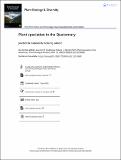Files in this item
Plant speciation in the Quaternary
Item metadata
| dc.contributor.author | Kadereita, Joachim W. | |
| dc.contributor.author | Abbott, Richard | |
| dc.date.accessioned | 2022-01-17T12:30:02Z | |
| dc.date.available | 2022-01-17T12:30:02Z | |
| dc.date.issued | 2022-01-12 | |
| dc.identifier | 276904235 | |
| dc.identifier | def3bf14-3448-4e2e-969c-7ee228b962e1 | |
| dc.identifier | 000741833200001 | |
| dc.identifier | 85122812046 | |
| dc.identifier.citation | Kadereita , J W & Abbott , R 2022 , ' Plant speciation in the Quaternary ' , Plant Ecology & Diversity , vol. 14 , no. 3-4 , pp. 105-142 . https://doi.org/10.1080/17550874.2021.2012849 | en |
| dc.identifier.issn | 1755-0874 | |
| dc.identifier.uri | https://hdl.handle.net/10023/24675 | |
| dc.description.abstract | Background : There are conflicting views between palaeobotanists and plant systematists / evolutionary biologists regarding the occurrence of plant speciation in the Quaternary. Palaeobotanists advocate that Quaternary speciation was rare despite opposing molecular phylogenetic evidence, the extent of which appears underappreciated. Aims : To document, describe and discuss evidence for Quaternary plant speciation across different geographical regions based on dated molecular phylogenies and related studies. Methods : From a search of the literature we compiled a selection mainly of dated molecular phylogenies from all continents (except Antarctica) and from all major climate zones. Results : Molecular phylogenetic analyses and related studies show that Quaternary plant speciation and radiations occurred frequently and that in many instances Quaternary climatic oscillations were likely important drivers of them. In all geographical regions studied Quaternary plant speciation and radiations were particularly evident in mountainous areas and arid regions, and were also prevalent on all major oceanic archipelagos. Conclusions : Based on our survey of the molecular phylogenetic and related literature we propose there is now overwhelming evidence that plant speciation and radiations were ubiquitous during the Quaternary. We therefore reject the view of palaeobotanists that plant speciation was rare during this period and briefly discuss possible reasons for this discrepancy. | |
| dc.format.extent | 38 | |
| dc.format.extent | 18222843 | |
| dc.language.iso | eng | |
| dc.relation.ispartof | Plant Ecology & Diversity | en |
| dc.subject | Quaternary | en |
| dc.subject | Speciation | en |
| dc.subject | Climatic oscillations | en |
| dc.subject | Molecular phylogenies | en |
| dc.subject | Palaeobotany | en |
| dc.subject | Plant evolution | en |
| dc.subject | Plant radiations | en |
| dc.subject | Pleistocene | en |
| dc.subject | QK Botany | en |
| dc.subject | DAS | en |
| dc.subject | NIS | en |
| dc.subject.lcc | QK | en |
| dc.title | Plant speciation in the Quaternary | en |
| dc.type | Journal item | en |
| dc.contributor.institution | University of St Andrews. School of Biology | en |
| dc.identifier.doi | https://doi.org/10.1080/17550874.2021.2012849 | |
| dc.description.status | Peer reviewed | en |
This item appears in the following Collection(s)
Items in the St Andrews Research Repository are protected by copyright, with all rights reserved, unless otherwise indicated.

